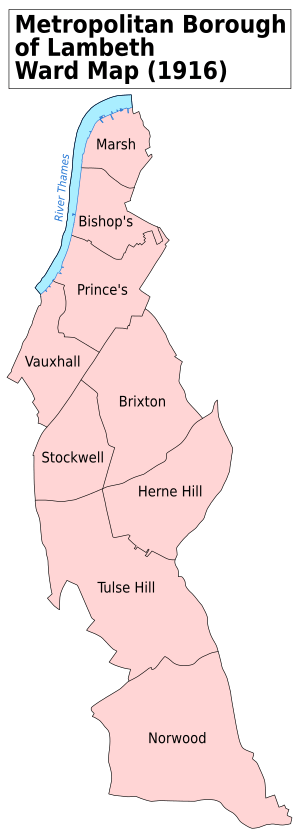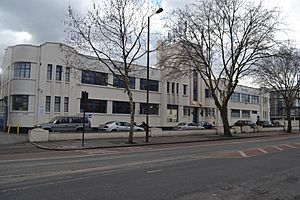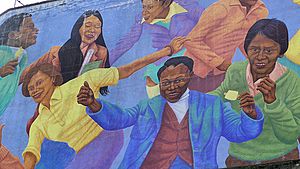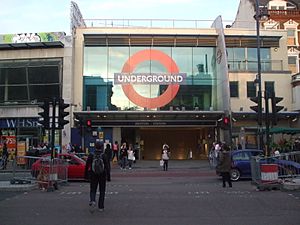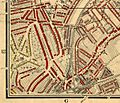Brixton facts for kids
Quick facts for kids Brixton |
|
|---|---|
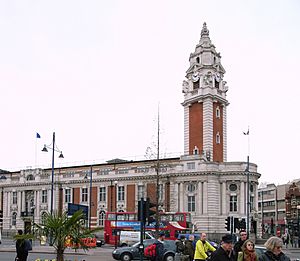 Lambeth Town Hall |
|
| Population | 78,536 (2011 census) |
| OS grid reference | TQ315755 |
| • Charing Cross | 3.8 mi (6.1 km) N |
| London borough | |
| Ceremonial county | Greater London |
| Region | |
| Country | England |
| Sovereign state | United Kingdom |
| Post town | LONDON |
| Postcode district | SW2, SW9 |
| Dialling code | 020 |
| Police | Metropolitan |
| Fire | London |
| Ambulance | London |
| EU Parliament | London |
| UK Parliament |
|
| London Assembly |
|
Brixton is a lively area in South London, England. It's part of the London Borough of Lambeth. Brixton is known as one of the 35 main centres in Greater London.
In the 1800s, Brixton grew very quickly. This happened as it became easier to travel to and from central London. Today, Brixton is mostly a place where people live. It also has a famous street market and many shops. It's a community with many different cultures, especially people of Afro-Caribbean background. Brixton is close to other areas like Stockwell, Clapham, and Streatham. The main offices for the Lambeth London Borough Council are also in Brixton.
Brixton is about 2.7 miles (4.3 km) south-southeast of central London. You can find it near Brixton Underground station on the Victoria Line.
Contents
History
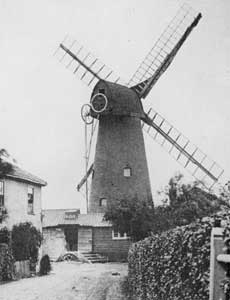
How Brixton Began (Until the Mid-1900s)
The name Brixton probably comes from "Brixistane." This means "Brixi's stone." Brixi was a Saxon lord. He may have set up a stone to mark a meeting place for an old court. This was long before any town grew there.
Brixton is located where the land rises from the marshes of North Lambeth. It goes up to the hills of Upper Norwood. The River Effra used to flow through Brixton. Roman roads, now Brixton Road and Clapham Road, crossed this river.
For a long time, Brixton was mostly farmland and market gardens. It was known for game and strawberries. The area didn't really develop until the early 1800s. When Vauxhall Bridge opened in 1816, it made it easier to get to Central London. This led to more houses being built.
One of the few windmills still standing in London is in Brixton. It was built in 1816. It is now surrounded by houses built during Brixton's growth in the Victorian era.
Brixton changed into a middle-class area between the 1860s and 1890s. Railways connected Brixton to central London in the 1860s. In 1880, Electric Avenue became famous. It was the first street in London to be lit by electricity. At this time, large houses were built. Later, these houses became flats and boarding houses.
By 1925, Brixton was a busy place. It had the biggest shopping centre in South London. It also had a lively market, cinemas, and theatres. Today, Brixton Road is the main shopping area. It connects to Brixton Market. Morleys, a department store, has been on Brixton High Street since the 1920s.
On the edge of Brixton, near Clapham, is the Sunlight Laundry. It's an Art Deco factory building from 1937. It's special because it's still used for its original purpose.
Brixton was bombed during World War II. This caused a housing shortage. Many old buildings were taken down, and new council housing was built. In the 1940s and 1950s, many people moved to Brixton. A large number came from the West Indies. More recently, people from Portugal and other European countries have moved here.
1948: The Windrush Generation

In 1948, the first group of immigrants arrived in Britain. They came from the Caribbean on a ship called the MV Empire Windrush. Many of these 492 people were housed near Brixton. The closest Jobcentre was in Brixton. So, many of these new arrivals found places to live nearby.
Many people planned to stay for only a few years. But most ended up settling permanently. The arrival of the Windrush is a very important moment in British history. It marks the start of modern British multicultural society. In 1998, the area in front of the Tate Library in Brixton was named "Windrush Square." This was to celebrate 50 years since the Windrush arrived.
Changes in the 1990s
In 1995, there were protests in Brixton. These events were linked to concerns about changes in the area.
Former Prime Minister John Major grew up in Brixton. This was used in a campaign poster in 1992. It highlighted his journey from Brixton to becoming Prime Minister.
On April 17, 1999, a bomb exploded in Electric Avenue. This happened on a market day. The bombing targeted the black community in Brixton. The same bomber also attacked areas important to the Bangladeshi community and the gay community in London. These events caused great sadness and concern.
Brixton's Modern Look
There's a lot of talk about how Brixton is changing. Some people think the area is becoming "gentrified." This means wealthier people are moving in. They are attracted by Brixton's location and its growing art scene. Others believe the area is simply getting better.
Recently, Brixton has started a regular farmers' market. There are also many new cafes, art galleries, and vintage clothing stores. These new businesses, especially in Brixton Village Market, are changing the area. In 2013, Brixton won "The Great Neighbourhood Award" for the UK and Ireland. In 2015, some local people held a "Reclaim Brixton" protest. They wanted to highlight their concerns about the changes.
Brixton as a Transition Town
Brixton was one of the first "Transition Town" projects in the UK. These projects aim to make communities more sustainable. Brockwell Park hosts the yearly Urban Green Fair. This event first took place in 2007.
Brixton Pound
| Brixton pound | |
|---|---|
| User(s) | Brixton |
The Brixton Pound is a special local currency. It was launched in 2009. You can use it instead of the pound sterling in Brixton. Many local businesses accept it. Other towns in the UK also have their own currencies.
The Brixton Pound helps the local economy. It encourages people to shop at local stores. It also helps local shops buy goods and services from other local businesses. The notes come in different values. They feature local famous people like Olive Morris and James Lovelock. In 2011, an electronic version of the currency was launched. You can pay with it using text messages.
New designs for the Brixton Pound notes were later released. They feature more people with Brixton connections. These include Len Garrison, Luol Deng, David Bowie, and Violette Szabo. The back of the notes show famous local places. These include the Stockwell Skatepark and the Brixton murals.
Brixton Market

When the railway came to Brixton in the 1870s, the area grew quickly. Brixton became a major shopping centre. The first department store, Bon Marché, opened in 1877. Electric Avenue was one of the first shopping streets with electric lights.
The famous Brixton Market started in Atlantic Road. It moved to Station Road in the 1920s to help with traffic. Brixton Market is open every day. It sells many Afro-Caribbean products. It also has Indian, Vietnamese, and South American shops. A farmers market also opens on Brixton Station Road every Sunday.
Culture
Brixton Murals
After some community unrest in 1981, the local council funded a series of murals. These large paintings show nature, politics, and community ideas. One surviving mural is the Brixton Academy Mural. It shows young people from different backgrounds. It aims to show how people can live together in harmony.
Entertainment
The Ritzy Cinema on Coldharbour Lane is a historic cinema. It was built in 1910. It was one of England's first cinemas built just for showing movies.
Brixton has a big clubbing and live music scene. Large venues include Brixton Academy and Electric Brixton. Many smaller venues also host live music. The Brixton Splash is a yearly street party. It started in 2006. It celebrates local talent and Brixton's diverse culture.
Brixton also has a skatepark built in the 1970s. It's called Stockwell Skatepark. Locals often call it Brixton Beach.
Music Scene
In recent years, Brixton has been important for UK Grime and Hip hop music. It's also known for Road Rap.
Religious Sites
Brixton Synagogue
Brixton Synagogue opened in 1913 on Effra Road. It closed in 1986. Its members then joined the Streatham Synagogue. The front of the building is still there.
Christian Churches
Brixton has several Christian churches. St Matthew's Church, Brixton was built in 1822. It is a beautiful building in the Greek Revival style. It was one of the "Waterloo churches." These churches were built to celebrate Britain's victory at the Battle of Waterloo.
St. Saviour's Church was used for filming a movie. It appeared in Alfred Hitchcock's The Man Who Knew Too Much in 1955.
Christ Church on Brixton Road is a Grade II* listed building. It was built in 1902. Corpus Christi Church is a Roman Catholic church in Brixton.
Brixton Mosque
The Masjid ibn Taymeeyah, also known as Brixton Mosque, is on Gresham Road. It opened in 1990. It is one of the oldest mosques in South London. It has space for 400 people to pray. The mosque helps its members with religious, social, and financial support.
The mosque has been in the news. Some people who later became involved in extremism had visited the mosque. However, the mosque's leaders have always spoken out against terrorism. They work to show that the local Brixton community is welcoming to Muslims.
In Popular Culture
Film and Television
- The 2001 film South West Nine (SW9) was filmed in Brixton. Its name refers to the postcode for much of central Brixton.
- Sarah Manning, a character from the TV show Orphan Black, is from Brixton.
Transport
Buses
Many London Buses routes serve Brixton. These include routes 2, 3, 35, 37, 45, 59, 109, 118, 133, 159, 196, 250, 322, 333, 345, 355, 415, 432, P4, P5, N2, N3, N35, N109, and N133.
London Underground
The closest Underground station is Brixton. It is on the Victoria line.
National Rail
The closest National Rail station is Brixton. You can catch Southeastern trains here. They go towards London Victoria and Orpington. This station is very close to the Underground station.
Road Network
Brixton is on several main roads. The A203, A204, and A2217 roads connect the area to Vauxhall Bridge. The A23 road, which goes from London to Brighton, also runs through Brixton.
Notable People


Many famous people have lived in or have connections to Brixton. Three people have special blue plaques on their former homes:
- C. L. R. James, a writer and black political activist.
- Dan Leno (1860–1904), a famous English comedian.
Other notable people connected to Brixton include:
- David Bowie was born in Brixton.
- Former London Mayor Ken Livingstone grew up and lived in Brixton for many years.
- Poet Linton Kwesi Johnson has lived in Brixton for a long time.
- Former British Prime Minister John Major spent part of his childhood here.
- Musicians Paul Simonon and Mick Jones from the band The Clash are both from Brixton.
- The bands Alabama 3 and Basement Jaxx were formed in Brixton.
- Sharon Osbourne, wife of Ozzy Osbourne, was born in Brixton.
- Mike Skinner from the band "The Streets" moved to Brixton. Some of his songs are about living there.
- Skin, singer of the band Skunk Anansie, grew up in Brixton.
- Environmentalist James Lovelock, known for the Gaia hypothesis, was born and grew up in Brixton.
- Olympic athlete Iwan Thomas.
- Basketball player Luol Deng lived and played in Brixton.
- Rapper Ty.
- Singer and TV personality Lisa Maffia was brought up in Brixton.
- Musician La Roux (Elly Jackson) was born and raised in Brixton.
- Artist Hew Locke has lived in Brixton for over 20 years. He says Brixton and its market inspire his work.
- Clive Dunn, an actor known for Dad's Army, was born in Brixton.
- Jean Kent, an actress, was born in Brixton.
- Rapper AJ Tracey was born in Brixton.
- Boxer Dillian Whyte grew up in Brixton.
- Rapper Dave was born in Brixton.
Images for kids
-
Electric Avenue, which inspired the song by Eddy Grant.
See also
 In Spanish: Brixton para niños
In Spanish: Brixton para niños



